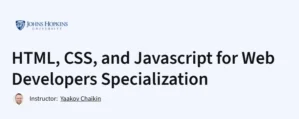HTML and CSS in depth Course
An ideal course for intermediate learners to polish their HTML and CSS skills and build responsive, accessible, and styled webpages like a pro.
What will you learn in HTML and CSS in depth Course
Build fully structured webpages using semantic HTML.
Style responsive and visually appealing layouts with CSS.
Apply best practices in accessibility and responsive design.
Develop reusable styles with advanced CSS techniques.
Program Overview
Module 1: Advanced HTML Concepts
⏱️ 1 week
Topics: Semantic HTML, tables, forms, and multimedia.
Hands-on: Create accessible and structured content with semantic tags.
Module 2: CSS Positioning and Layouts
⏱️ 1 week
Topics: Flexbox, Grid, positioning schemes.
Hands-on: Build page layouts that adjust across screen sizes.
Module 3: Responsive Web Design
⏱️ 1 week
Topics: Media queries, mobile-first design, viewport configuration.
Hands-on: Build a responsive landing page.
Module 4: Advanced CSS Styling
⏱️ 1 week
Topics: Variables, pseudo-classes, animations, and transitions.
Hands-on: Design a modern and interactive user interface.
Get certificate
Job Outlook
HTML & CSS remain core web development skills for frontend jobs.
Used across roles like web developers, UI designers, and content developers.
Strong demand in freelance marketplaces, startups, and media companies.
Salaries: $45K–$85K depending on role, location, and stack.
- Created by Meta professionals
- Highly practical with real-world layout techniques
- Emphasizes modern responsive design
- Focuses only on frontend—no JavaScript
- Requires prior knowledge of basic HTML and CSS
Specification: HTML and CSS in depth Course
|
FAQs
- No prior web development experience is required; the course starts from foundational concepts.
- Basic familiarity with computers and browsers is helpful but not mandatory.
- Step-by-step lessons introduce HTML elements, CSS styling, and page layout.
- Hands-on exercises allow learners to build web pages from scratch.
- Beginners can gradually develop confidence in creating responsive and well-structured websites.
- The course includes exercises for writing HTML and CSS code.
- Learners practice styling pages, creating layouts, and formatting content.
- Real-world examples demonstrate best practices in web design.
- Step-by-step guidance ensures proper structure and responsive design.
- Hands-on projects help learners build a portfolio of web pages to showcase skills.
- Learners are introduced to Flexbox, Grid, and media queries for responsive layouts.
- CSS variables, animations, and transitions are explained and applied.
- Practical exercises show how to create websites that work on multiple devices.
- Knowledge gained helps improve usability and user experience.
- Skills are directly applicable to frontend development projects.
- HTML and CSS are fundamental skills for frontend development roles.
- Knowledge improves employability for web designer, frontend developer, and UI/UX roles.
- Hands-on projects demonstrate practical ability to potential employers.
- Understanding modern CSS techniques supports advanced web development frameworks.
- Completion shows readiness to contribute to professional web development projects.
- Estimated completion is around 3–5 weeks at a part-time pace.
- Weekly effort of 3–5 hours is generally sufficient for lectures and hands-on exercises.
- Regular practice in creating pages and styling reinforces learning.
- Revisiting exercises or experimenting with additional layouts may require extra time.
- Consistent engagement ensures learners develop both foundational and advanced HTML/CSS skills.





